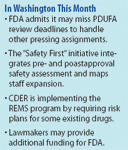Attacks on FDA Escalate
Regulators face demands to improve postmarket surveillance and meet review deadlines.
The US Food and Drug Administration faces challenges on all sides. Federal legislators approved a significant expansion of the agency's authority to regulate drug safety and data disclosure in fall 2007, but the new powers have not provided any hiatus from outside investigations and public attacks.

Jill Wechsler
The heparin scandal has intensified scrutiny of how FDA regulates the growing volume of imported drugs and pharmaceutical ingredients. Questions about the efficacy of popular cholesterol and diabetes treatments have prompted charges of insufficient premarket testing and lax oversight. And FDA's slow response to evidence of research fraud for Sanofi-Aventis's (Paris) antibiotic "Ketek" (telithromycin) prompted Congressional leaders to call for more effective enforcement of clinical research requirements.
FDA has become a popular target on Capitol Hill and in the press. Influential members of Congress don't trust FDA to monitor industry appropriately. Some have found it politically expedient to sound alarms about inadequate oversight of food and drug safety and human research programs. In February, Rep. Bart Stupak (D-MI), chairman of the House Energy and Commerce Oversight and Investigations subcommittee, called for FDA Commissioner Andrew von Eschenbach and other top FDA officials to resign, citing their "total lack of leadership" of the agency.

In Washington This Month
Late last year, House appropriators killed a direct-to-consumer advertising user fee authorized by the FDA Amendments Act (FDAAA) largely because they thought FDA fails to forcefully regulate drug advertising. Lawmakers nixed funding for the new Reagan–Udall Foundation because of fears it would permit pharmaceutical companies to exert more influence on agency research programs.
FDA officials feel the heat. Janet Woodcock, director of the Center for Drug Evaluation and Research (CDER), told the House Appropriations subcommittee in February that FDA is "an agency under assault" and that continued attacks make it more difficult to attract and retain the scientists the agency needs. Former CDER Director Carl Peck echoed Woodcock's remarks at the annual meeting of the Food and Drug Law Institute (FDLI) in March. He described FDA as operating in a "guerilla environment" created by "ambitious politicians, media competing for headlines, and opportunistic academics." The latest "roadside bomb," said Peck, was a widely cited study published in The New England Journal of Medicine indicating that new drugs approved close to user fee deadlines are less safe than those approved without such time pressures.
Although this report appeared as one more piece of evidence that drug companies are thrusting unsafe products onto the market because of ineffective regulatory oversight, FDA says it's not true. CDER Deputy Director Douglas Throckmorton claimed that agency approval and withdrawal data is "considerably different" from what the study reported and that it's common to approve drug applications within two months of a review deadline. FDA plans to submit its own analysis to the Journal, but even a strong refutation is unlikely to make front-page news.
Depleted resources
FDA has difficulty meeting the high expectations of all its constituencies because of an ever-expanding portfolio of oversight and regulatory responsibilities. The agency's depleted resources and decimated work force are other problems. The need to establish a host of new rules and policies to implement FDAAA makes matters worse, at least for the short run. And pressure to beef up CDER's postapproval surveillance operations has increased strain on the new-drug approval process.
Comments from John Jenkins, director of CDER's Office of New Drugs (OND), provide a clear view into FDA's dilemma. He gave review division chiefs "discretion" to reduce work on some activities to deal with a high-priority requirement, even if that means missing user-fee deadlines. Jenkins explained to reporters that his office cannot keep up with a growing volume of requests to meet with sponsors, provide Special Protocol Assessments for innovative therapies, supply the reams of information demanded by Congressional committees, and still perform routine tasks. Jenkins thus advised OND office and division directors to assess where it will be difficult to meet application-review goals set by the latest Prescription Drug User Fee Act (PDUFA IV) and to notify sponsors of anticipated delays.
Jenkins noted that there is "no specific end date" to the possibility of missing PDUFA deadlines because it may take FDA years to hire the necessary personnel to remedy the situation. Under PDUFA IV, CDER has resources to add some 400–500 additional staffers, but the task of hiring and training a whole new team of reviewers and analysts will consume considerable time and energy (see sidebar, "Seeking scientists").

Seeking scientists
For pharmaceutical companies, this development raises the prospect of added costs and delays in bringing new drugs to market, a trend evident in FDA's declining drug-approval rate. The agency approved only 19 innovative new drugs in 2007, 17 new molecular entities, plus two novel biotechnology therapies. Those numbers are way down from the peak of 53 new drugs in 1996, but in line with a steady decline in new-drug approvals since 2002. Another analysis indicates that FDA approved only 64% of all New Drug Applications (NDAs) in 2007 and issued more nonapprovable and approvable letters that request additional data and information from sponsors for final approval.
Manufacturers say these trends reflect a cautious environment at the agency in approving new drugs. FDA officials maintain that they have not changed standards or become more risk-averse, but now have better tools for detecting safety problems, especially for drugs that treat chronic conditions. At the same time, FDA officials acknowledge that new treatments in crowded drug classes will have to show an efficacy or safety advantage to gain market approval.
Expanded responsibilities
One factor interfering with CDER's review process is the need to spend more time and resources implementing new postmarket surveillance programs. CDER's new "Safety First" initiative reflects the prominence CDER will give to safety issues in evaluating NDAs. The aim is to better integrate pre- and postapproval safety assessments to avoid clashes between OND and CDER's Office of Surveillance and Epidemiology (OSE). A Safety First steering committee is clarifying internal processes for managing "significant safety issues," Woodcock said in a staff memo. A safety director and managers in each new-drug review office will oversee and coordinate safety assessment, which will be performed by interdisciplinary teams that include staffers from both offices.
Woodcock notes that OSE will have lead regulatory responsibility for observational epidemiologic studies and medication error prevention, including review of proprietary names, packaging, and container labeling. But safety officers won't get a veto over approvals, as some critics both inside and outside the agency have recommended.
OSE is reorganizing to handle its growing portfolio of postmarket surveillance activities. It has expanded from three to five divisions to better monitor adverse events and weigh safety issues in applications. And OSE Director Gerald Dal Pan heads expanded management, communications, and policy development staffs. One new task for OSE is to develop summaries of adverse drug events within 18 months of market approval or after a new drug is used by 10,000 patients, as stipulated by FDAAA (see sidebar, "Postmarket safety evaluation"). Such summaries will identify new and potential product risks and increased incidence of known risks.

Postmarket safety evaluation
Another important assignment for OSE is to oversee the new Risk Evaluation and Mitigation Strategies (REMS) program. In March, FDA published a list of 25 approved drugs that already have a restricted distribution system to ensure the products are used safely. Manufacturers of drugs on the list must file new REMS proposals with FDA by September 21, 2008. Listed drugs include innovator and generic versions of clozapine for schizophrenia, the acne treatment isotretinoin, natalizumab, thalidomide, mifepristone, alosetron, and fentanyl citrate.
The announcement also clarifies that FDA can require REMS for new drugs that warrant similar controls on dispensing and patient use. The initial REMS list does not include products that carry MedGuides to support appropriate product use, but a drug in that category might trigger a REMS in the future. FDA plans to issue guidance on the content and format of a REMS to clarify the key elements of a plan for manufacturers who develop new drugs that raise patient-safety concerns.
Drug-safety experts also will take part in FDA's expanded efforts to publicize information about drug-safety signals as they emerge. The same week that FDA published its REMS policy, it also issued several Early Communications about emerging safety issues. One communication involved new signals of heart attack risks involving two leading AIDS therapies, GlaxoSmithKline's (London) "Ziagen" (abacavir) and Bristol-Myers Squibb's (New York) "Videx" (didanosine). The agency also said it would conduct a safety review of Johnson & Johnson's (New Brunswick, NJ) "Regranex" skin gel for diabetics (becaplermin) to assess links to cancer and death. And FDA is investigating a possible connection between suicidality and Merck and Co.'s (Whitehouse Station, NJ) popular asthma treatment "Singulair" (montelukast).
These notices aim to provide information on possible medication problems so that medical professionals can alert patients appropriately. The danger is that these warnings often trigger overreactions that lead to noncompliance. Equally disturbing is the prospect that a proliferation of FDA safety warnings may prompt patients and providers to ignore the alerts. FDA has issued more public-health advisories in recent months than in most preceding years. The agency's new Risk Communication Advisory Committee is working with agency staffers to improve methods for communicating risks and benefits regarding drugs, medical devices, and foods so that the public will respond appropriately.
Recommended funding
Fortunately, the growing consensus is that FDA needs a major infusion of cash to regain its stature as an effective, science-based regulatory agency. Senate Health, Education, Labor, and Pensions Committee Chairman Edward Kennedy (D-MA) added an amendment to the Senate budget resolution for 2009 that supports an extra $71 million for FDA. The extra money could bring FDA's total budget to $2.2 billion if adopted by Congress in the next few months.
That funding level fits recommendations from agency advocates to double the FDA budget over the next five years. Advocates seek a budget of nearly $4 billion by 2013. This goal has support from members of the subcommittee to FDA's Science Board and other groups. FDA needs a "substantial increase in resources if it is to protect us as the public expects and Congress demands," wrote Subcommittee Chair Gail Cassell of Eli Lilly (Indianapolis, IN) in response to requests from Congress. Democratic leaders on Capitol Hill praised the group's funding proposal. They also pointed to FDA's current tight budget as a symptom of how the Bush administration has "shortchanged" the agency. The Government Accountability Office has agreed to provide Congress with a report about FDA's resource needs for "proper operation." This report should further highlight the agency's funding challenges.
In his last months as FDA commissioner, von Eschenbach has become more open about FDA's budgetary problem. In a speech at the National Press Club in February, he acknowledged that FDA's resources "have not kept pace" with its growing responsibilities. In a similar address at the March FDLI meeting, von Eschenbach described FDA as a "patient in peril." He said the agency's expanding responsibilities are made more complex by globalization, bioterrorism, just-in-time delivery demands, and a continuing need for crisis control. Increased FDA reliance on user fees limits the agency's flexibility, von Eschenbach noted. He urged "full backing" for the Reagan–Udall Foundation. "FDA needs to be stronger, bigger, and better," he said, if it is to continue to be "the world's gold standard as a regulatory agency."
Jill Wechsler is Pharmaceutical Technology's Washington editor, 7715 Rocton Ave., Chevy Chase, MD 20815, tel. 301.656.4634, jwechsler@advanstar.com

Pharmaceutical Tariffs Are Imminent: How Industry is Bracing for Impact
April 16th 2025On April 14, 2025, the Trump Administration launched a national security-driven investigation into pharmaceuticals, a move that will likely result in tariffs being placed on pharmaceutical drugs, ingredients, and other components that are imported from outside of the United States.